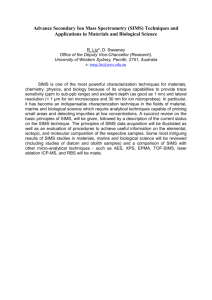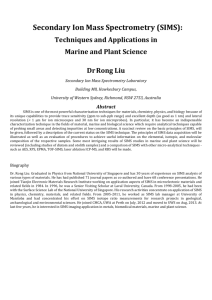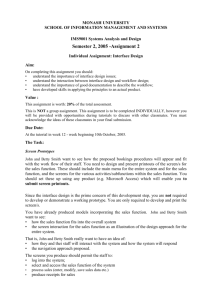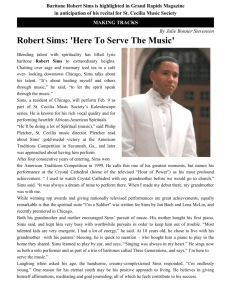~*~ John F. Sims An Evolution Not a Revolution, 1906-1926
advertisement
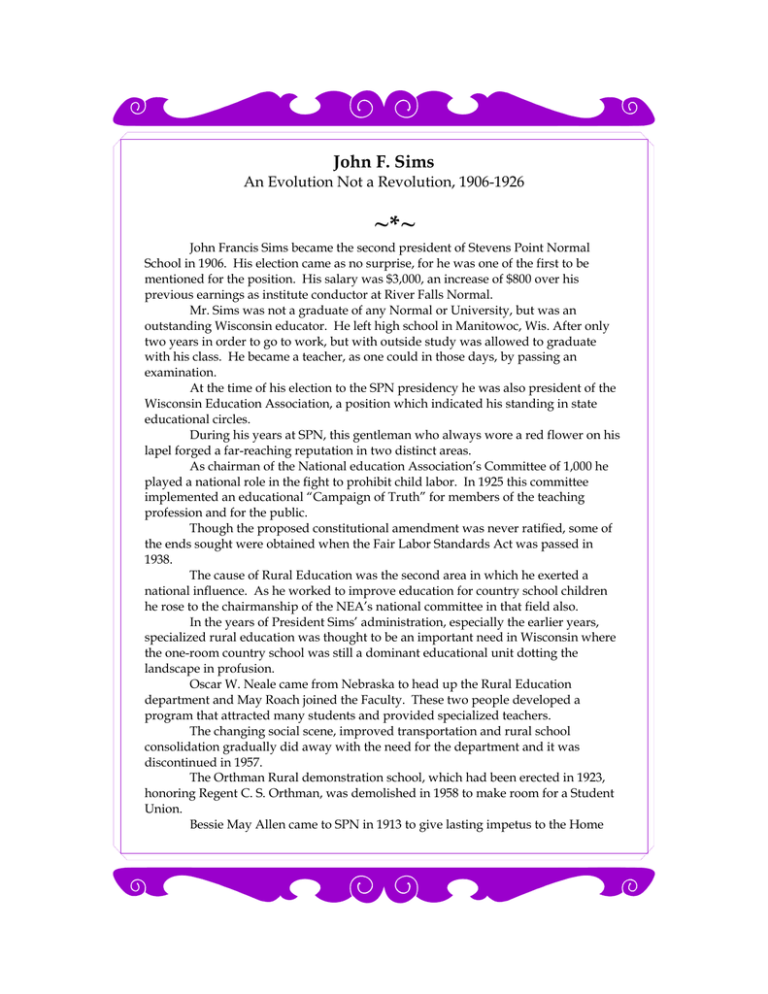
John F. Sims An Evolution Not a Revolution, 1906-1926 ~*~ John Francis Sims became the second president of Stevens Point Normal School in 1906. His election came as no surprise, for he was one of the first to be mentioned for the position. His salary was $3,000, an increase of $800 over his previous earnings as institute conductor at River Falls Normal. Mr. Sims was not a graduate of any Normal or University, but was an outstanding Wisconsin educator. He left high school in Manitowoc, Wis. After only two years in order to go to work, but with outside study was allowed to graduate with his class. He became a teacher, as one could in those days, by passing an examination. At the time of his election to the SPN presidency he was also president of the Wisconsin Education Association, a position which indicated his standing in state educational circles. During his years at SPN, this gentleman who always wore a red flower on his lapel forged a far-reaching reputation in two distinct areas. As chairman of the National education Association’s Committee of 1,000 he played a national role in the fight to prohibit child labor. In 1925 this committee implemented an educational “Campaign of Truth” for members of the teaching profession and for the public. Though the proposed constitutional amendment was never ratified, some of the ends sought were obtained when the Fair Labor Standards Act was passed in 1938. The cause of Rural Education was the second area in which he exerted a national influence. As he worked to improve education for country school children he rose to the chairmanship of the NEA’s national committee in that field also. In the years of President Sims’ administration, especially the earlier years, specialized rural education was thought to be an important need in Wisconsin where the one-room country school was still a dominant educational unit dotting the landscape in profusion. Oscar W. Neale came from Nebraska to head up the Rural Education department and May Roach joined the Faculty. These two people developed a program that attracted many students and provided specialized teachers. The changing social scene, improved transportation and rural school consolidation gradually did away with the need for the department and it was discontinued in 1957. The Orthman Rural demonstration school, which had been erected in 1923, honoring Regent C. S. Orthman, was demolished in 1958 to make room for a Student Union. Bessie May Allen came to SPN in 1913 to give lasting impetus to the Home Economics department. It was then called Domestic Science. Other long-term members of this department, which was to become one of the school’s best known, were Nancy Jane Church, Helen Meston and Emily Wilson. A good friend of the University who served in that department for a time is Cornelia Luce Cowan. An east wing was added to the Main building in 1914 to house Home Economics and an auditorium. Later a duplex home management house called the Sims Cottage was added on Fremont Street. It is said to have been the first college home management house in the nation. Nelson Hall was the first campus dormitory, built in 1915 and named to honor Regent George B. Nelson. It was a women’s residence through most of the years since except for those periods during the wars when men students in armed services education programs lived there or when changing on-campus residence needs made it a short term home fore men. It was phased out as a residence hall in 1968. During the years of President Sims’ administration educational needs began to change rapidly. He was dean of the Normal School presidents and it was he who appointed a committee to develop the four-year programs at these institutions. As Wisconsin Normal schools pushed for degree granting status they came up against the powerful opposition of the University of Wisconsin and the state’s private colleges. It was a feud that had been going on for some years and had been especially virulent during the years before 1918 when Charles Van Hise was president of the UW. Fighting on the side of the Normal Schools was the State Superintendent of Schools, C.P. Cary. He opposed those who wanted the Normal Schools kept out of the high school field, for Wisconsin needed more teachers for its increasing numbers of public high schools. At one point in the struggle, Cary termed the state University a “spoiled child which had become head strong and self willed.” SPN was used to opposition. It had faced it from its very inception. “Because the academies and colleges looked down with contempt on the normals from the aloofness of their classical curriculums, the normals took a fierce joy in glorifying the branches of common everyday learning.” Perhaps, at this point in time, their finest accomplishment was that they were beginning to make a profession of teaching. Some of the criticism hurled was justified, for there is often a cultural lag in institutions when a particular need is past. It takes time to shift gears and there is always some inertia with which to contend. In the end the Normals won the right to be considered the chief agency for the education of teachers for both grade and high schools. Throughout the controversy SPN expanded its facilities and reacted to the needs of the public schools. When it because a Teachers College in 1926, it may have seemed a new institution to many, But in reality was not. It had merely adapted itself to changing economic and social situations as it has continued to do. It had gone through an evolution, not a revolution. With the changes there were growing pains. One problem would be the upgrading of the faculty at SPN in terms of educational qualifications. The school had many strong, excellent teachers who had been on the faculty for years. But there were not as many advanced degrees proportionately as there had been many years earlier and there were some who did not have even the baccalaureate, including the nationally esteemed President Sims. President Sims knew he was going to have to push his faculty to earn degrees he did not himself posses if Stevens Point were to be considered qualified to confer college degrees. This responsibility weighed heavily and he spoke of his dread of the task ahead of him to some of the people close to him. Mr. Sims was among the kindliest of men, strong in his sympathies for the individual and well loved by many faculty and students who referred to him as “Uncle John.” Fate spared him the task he dreaded. President Sims became ill and died in May of 1926, as SPN was about to become a Teachers College. His concern was justified. His successor was to find that task an insurmountable obstacle, which, along with other considerations, would serve to limit his term in the presidency. In the meantime the college and community were mourning the death of one of its finest citizens. Mr. Sims’ body lay in state in the college auditorium where faculty and students took turns as honor guards. A red carnation was on his lapel the day of his funeral. After the funeral his casket was borne between two long lines of students, across the diagonal walk on the front campus to the waiting hearse at the corner of Main and Reserve Streets. Edward J. Dempsey, President of the Board of Regents, eulogized his good friend that day: “Some men are born with the instinct of culture. John Sims was such a man. By instinct he also knew and understood the fundamentals of democracy and he dreamed of that brighter day when education will bring to the contacts of common life a vitalized culture and a humanized democracy.” By 1926 the High School department had the largest enrollment at SPN. E.T. Smith headed the department and he was later to become a president of the college. The Primary department was under James E. Delzell and the Grammar department under C.F. Watson, with Mr. Neale still heading the Rural and Miss Allen the Home Economics work. Frank Spindler was vice president. Bertha Hussey was dean of women and Herbert R. Steiner, dean of men, Leland M. Burroughs, Edna Carlsten, Gertie Hanson, Norman Knutzen, Raymond M. Rightsell, Miss Roach and Fred J. Schmeeckle were among the teachers who would continue to serve for many years. Dr. Joseph E. Collins was the only original faculty member from 1894.
